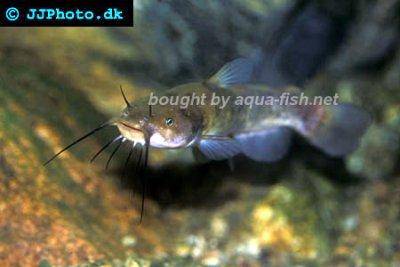Brown bullhead - Ameiurus nebulosus
Scientific name: Ameiurus nebulosus
Common name: Brown bullhead
Family: Ictaluridae
Usual size in fish tanks: 45 - 50 cm (17.72 - 19.69 inch)
014
Recommended pH range: 6.3 - 7.5
Recommended water hardness: 5 - 21°N (89.29 - 375ppm)
0°C 32°F30°C 86°F
Recommended temperature range: 15 - 28 °C (59 - 82.4°F)
The way how these fish reproduce: Spawning
Where the species comes from: North America
Temperament to its own species: peaceful
Temperament toward other fish species: aggressive to smaller
Usual place in the tank: Bottom levels
Origin
Native to North America, the Brown Bullhead can be found in various waterways stretching from Canada all the way down to Louisiana in the United States. They inhabit lakes, rivers, and ponds, often thriving in slow-moving or still waters with muddy or silty substrates. This species has also been introduced to other parts of the world, including Europe and Asia, where it can adapt to a wide range of environments.
Food and Feeding
As with many large catfish, Brown Bullheads are not picky eaters and will consume almost anything that fits into their mouths. They are opportunistic bottom feeders, thriving on a varied diet. In the aquarium, they should be offered a mix of high-quality sinking pellets, algae wafers, and protein-rich foods such as earthworms, prawns, and shrimp. They will also accept frozen or live foods like bloodworms, small fish, and insects. Due to their voracious appetite, it’s important not to overfeed, as this can lead to water quality issues.
Sexing
Distinguishing between male and female Brown Bullheads is difficult, as they do not exhibit obvious sexual dimorphism. The males and females look similar in size and appearance, making it nearly impossible to differentiate based on visual inspection alone.
Breeding
There are no confirmed reports of Brown Bullheads breeding in captivity, but in their natural habitats, they breed by creating shallow pits in the substrate where the eggs are laid. The eggs are clumped together into a sticky mass, and after about 8 days, the fry hatch. In the wild, both parents often guard the nest and protect the young for several weeks until they are more independent. Replicating these conditions in an aquarium has proven challenging.
Lifespan
With proper care, Brown Bullheads can live for 6-8 years in an aquarium. In the wild, they may live longer due to more varied environments and natural breeding cycles.
Short Description
Brown Bullheads are large, robust catfish that require spacious aquariums due to their adult size, which can reach up to 50 cm (20 inches). They are best kept with similarly sized, robust tank mates, as they will attempt to eat any fish small enough to fit into their mouths. These catfish are hardy and can tolerate a range of water conditions, but their natural size and predatory nature mean they are only suitable for large aquariums. In some countries, such as the UK, a licence is required to keep Brown Bullheads due to their invasive potential and adult size. Provide ample hiding spaces with rocks, driftwood, and sturdy plants to mimic their natural habitat.
Pictures
Bought by aqua-fish.net from jjphoto.dk.




